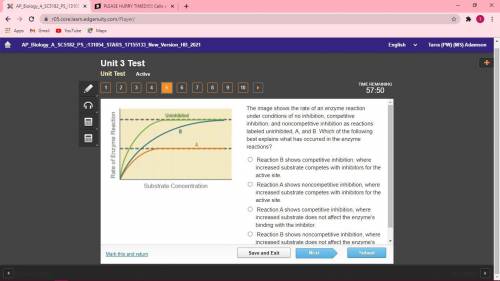
Biology, 06.12.2020 22:20, andrew8228
HURRY BEING TIMED The image shows the rate of an enzyme reaction under conditions of no inhibition, competitive inhibition, and noncompetitive inhibition as reactions labeled uninhibited, A, and B. Which of the following best explains what has occurred in the enzyme reactions?
Reaction B shows competitive inhibition, where increased substrate competes with inhibitors for the active site.
Reaction A shows noncompetitive inhibition, where increased substrate competes with inhibitors for the active site.
Reaction A shows competitive inhibition, where increased substrate does not affect the enzyme’s binding with the inhibitor.
Reaction B shows noncompetitive inhibition, where increased substrate does not affect the enzyme’s binding with the inhibitor.


Answers: 3
Other questions on the subject: Biology

Biology, 21.06.2019 22:00, samantha636
According to piaget, children have acquired the cognitive skill of conservation when they're able to a. understand that six ounces of liquid in a jar and six ounces in an elongated tube are equal. b. understand the viewpoint of other people. c. relate objects around them to their own needs. d. realize that the term heavy describes an object one way and the term big describes it another way. it is not b nor c. did this 2 x wrong..
Answers: 1

Biology, 22.06.2019 00:30, nayellisoto15
Compare and contrast cladistics and phylogeny. what are their advantages and disadvantages? which is the most useful in understanding how an organism developed into its current form? which concept most strongly supports your opinion about the origin of any given organism?
Answers: 1

Biology, 22.06.2019 02:30, ElegantEmerald
How can antibodies "remember" a particular bacterial invader or "antigen" on that invader?
Answers: 3

Biology, 22.06.2019 06:20, noahdeem135
What is the importance of having the us forest service, the bureau of land management, the us fish and wildlife service, and the national park service? to manage land resources for conservation and the development of natural resources to manage land resources for conservation and the development of urban areas to preserve historical landmarks and manage the development of urban areas to preserve historical landmarks and manage the development of rural areas
Answers: 3
Do you know the correct answer?
HURRY BEING TIMED The image shows the rate of an enzyme reaction under conditions of no inhibition,...
Questions in other subjects:




Mathematics, 13.12.2019 07:31


Mathematics, 13.12.2019 07:31









